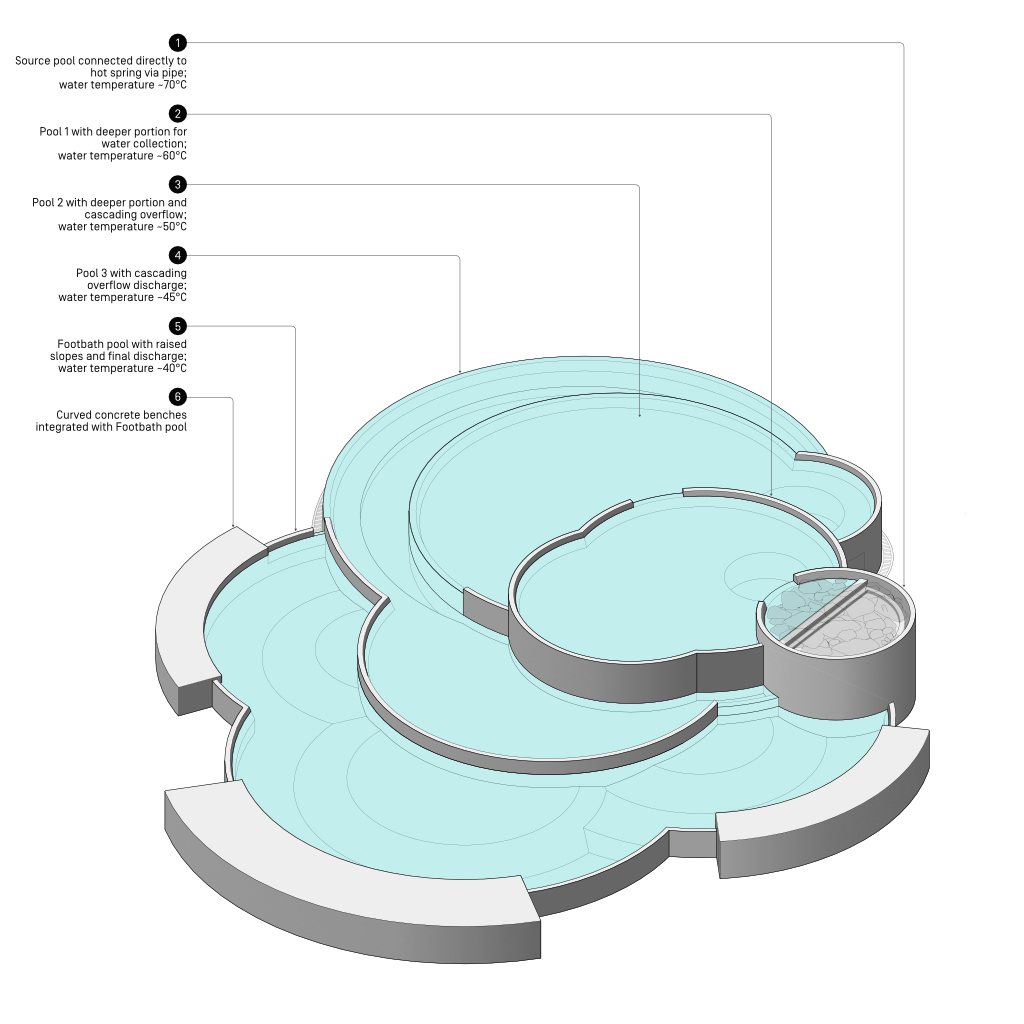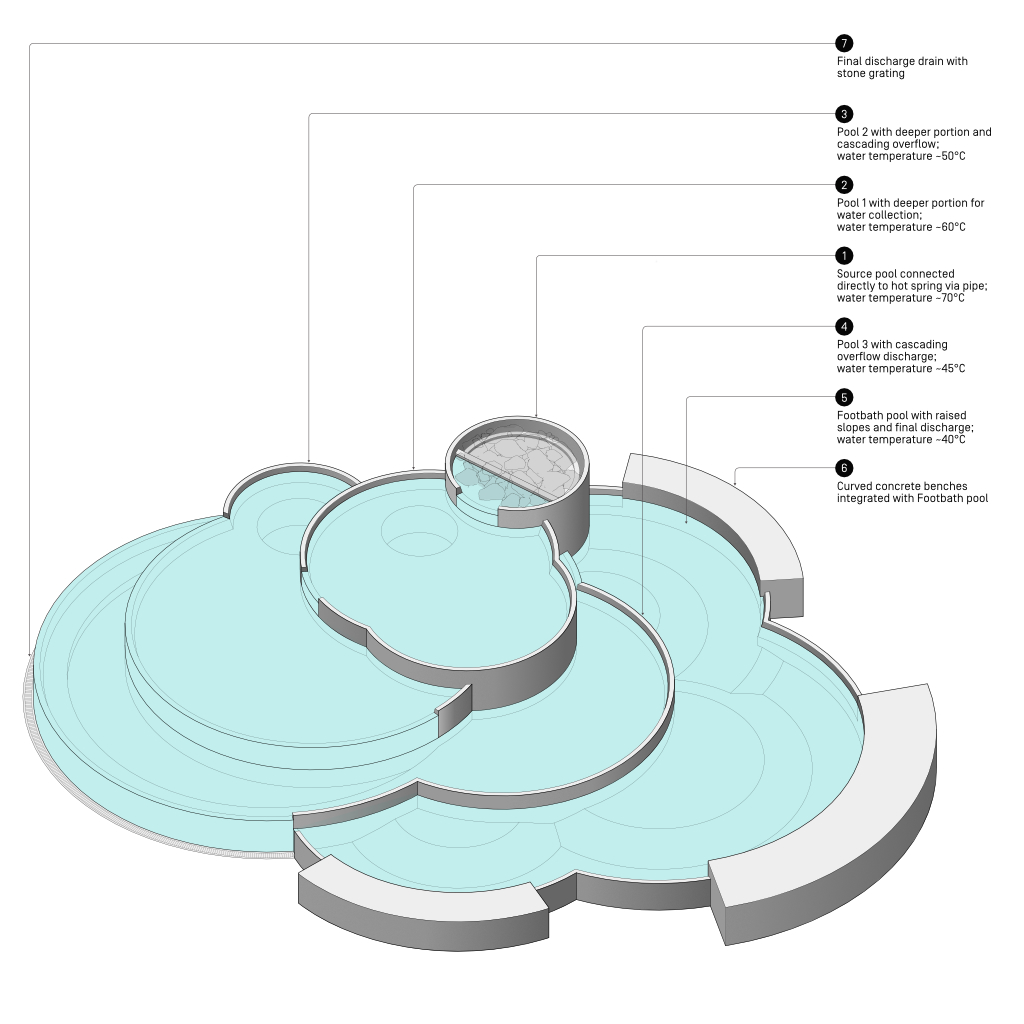Prototype
Passively cooled hot spring feature footbath
Discovered in 1909, Sembawang Hot Spring Park contains the only hot spring on mainland Singapore, a natural wonder that has attracted generations of curious visitors. Prior to the park enhancement in 2018, its spring water had been supplied through a series of taps emerging from a concrete hardscape surrounded by wild trees, where people gathered around in a makeshift fashion with plastic buckets and stools. Its physical condition – unbuilt and unpolished – gave rise to its charming rural atmosphere. With time, a faithful community of users has formed around the hot spring and its quiet, rustic surroundings, making it a local treasure. It has thus generated a unique locale within the city that retains spatial and cultural traits of the kampung—a vernacular way of village living.
Our enhancement work sought to not only preserve, but celebrate and carry forward this kampung spirit, with a focus on slow simplicity. Careful considerations were made to ensure the necessary construction would minimally impact the hot spring’s geological conditions, while enhancing usability and extending connections to nature. Openness and greenery were embraced, avoiding any imposing geometry, while materials were kept as raw as possible to project a rustic, nostalgic image reminiscent of kampung structures. The proposal thus engendered a lo-fi, inviting and communal approach—recalling the kampung—for new and existing users. This is expressed in the form of the central footbath feature. The employment of inclusive design, ergonomics and circular forms prioritized comfortable, democratic and safe use.
Specific to the new footbath to be built, a way of passively cooling the spring water and regulating its temperature was required. Drawing upon studies of heat transfer, we eventually conceived a generative form that fulfilled both thermodynamic and ergonomic functions, as detailed below.
Our enhancement work sought to not only preserve, but celebrate and carry forward this kampung spirit, with a focus on slow simplicity. Careful considerations were made to ensure the necessary construction would minimally impact the hot spring’s geological conditions, while enhancing usability and extending connections to nature. Openness and greenery were embraced, avoiding any imposing geometry, while materials were kept as raw as possible to project a rustic, nostalgic image reminiscent of kampung structures. The proposal thus engendered a lo-fi, inviting and communal approach—recalling the kampung—for new and existing users. This is expressed in the form of the central footbath feature. The employment of inclusive design, ergonomics and circular forms prioritized comfortable, democratic and safe use.
Specific to the new footbath to be built, a way of passively cooling the spring water and regulating its temperature was required. Drawing upon studies of heat transfer, we eventually conceived a generative form that fulfilled both thermodynamic and ergonomic functions, as detailed below.


The existing concrete slab with the hot spring taps was intended to be kept as the main area of activity within the park. To improve usability, a new footbath feature would allow visitors to enjoy the spring water without having to manually collect it from discharge outlets with their own pails.
The spring water which consistently flowed out at 70°C required some form of thermal regulation as it is too hot for comfortable human contact. Based on data provided, the optimal and safe temperature for a footbath would be 40 to 45°C, a figure that coincides with the ideal onsen temperature. From the outset, electrical methods of cooling were rejected due to invasiveness and prohibitive cost. The use of heavy machinery and materials was also discouraged due to the layout of the park, where a small, existing pedestrian footbridge separated the entrance from the spring area.
Having to approach the hot spring in the most primitive yet efficient way, we devised a passive cooling method using principles of surface area heat loss and retention of heat via mass. The aesthetic vision of a cascading motif to express water movement in the initial phase of the project further inspired our exploration of a using functional tiered system to implement these passive cooling methods.
A process of investigation and testing was undertaken, adjusting and applying formulae to calculate the required size and number of pools to achieve the desired heat loss as water flowed down from the source to each pool and into the footbath. In doing so, we were able to project the actual heat loss and temperature of each pool. These calculations allowed us to then determine and adjust the form of the footbath water feature, the final expression of which was a balance between the achievement of temperature and the ergonomics of usage.
The spring water which consistently flowed out at 70°C required some form of thermal regulation as it is too hot for comfortable human contact. Based on data provided, the optimal and safe temperature for a footbath would be 40 to 45°C, a figure that coincides with the ideal onsen temperature. From the outset, electrical methods of cooling were rejected due to invasiveness and prohibitive cost. The use of heavy machinery and materials was also discouraged due to the layout of the park, where a small, existing pedestrian footbridge separated the entrance from the spring area.
Having to approach the hot spring in the most primitive yet efficient way, we devised a passive cooling method using principles of surface area heat loss and retention of heat via mass. The aesthetic vision of a cascading motif to express water movement in the initial phase of the project further inspired our exploration of a using functional tiered system to implement these passive cooling methods.
A process of investigation and testing was undertaken, adjusting and applying formulae to calculate the required size and number of pools to achieve the desired heat loss as water flowed down from the source to each pool and into the footbath. In doing so, we were able to project the actual heat loss and temperature of each pool. These calculations allowed us to then determine and adjust the form of the footbath water feature, the final expression of which was a balance between the achievement of temperature and the ergonomics of usage.

ISO DETAIL OF CASCADING HOT SPRING FOOTBATH
The decision on the overall geometric form of the footbath feature was performance-based. As a function of its place, it needed to provide sufficient space for people to sit and gather around it, without having any specific axis that favoured any specific edge of the pool. A circular geometry consisting of arcs is inviting and suggests a communal facility. In consideration of safety, ergonomic comfort and maintaining the integrity of the spring water, the footbath was eventually tiered and sized in four layers, such that each tier would retain water about 10°C lower than the last until it reached 40°C.

ISO DETAIL OF CASCADING HOT SPRING FOOTBATH
With just four pools, users would remain in fair proximity to the direct source of the spring water, while limiting the factors that would impact the spring water if it were to travel a longer distance. The staggering of temperatures also serves a purpose in supplying the spring water at different temperatures for different uses. We regulated the pools to descending temperatures of 70, 60, 45 and 40°C – a steady spectrum with the final two falling within the optimal range for human contact. Water at the source, being the hottest, was deliberately made inaccessible at the tallest height, channeling into a shallow trough covered with large rocks – also a poetic gesture that references geothermal water coming through fissures in the ground. The 60°C pool was constructed at safety barrier height, while the bottom two layers with the most enjoyable temperatures were designed to be the most accessible.
TYPICAL SECTION DETAIL OF CASCADING HOT SPRING FOOTBATH
Further ergonomic and practical considerations were worked into the detailing of the water feature. The edge of each pool was treated differently, in a way that corresponds to its temperature and intended use. Though height restrictions were in place, the hotter pools still posed a potential safety hazard, so the 45 and 60°C pools had 300mm wide tapered lips all around its perimeter, creating a shallow edge to prevent people from soaking or accidentally falling into them. Every pool lip has a recessed portion to allow water to overflow into the next tier. Only the footbath pool is designed without lips and instead, has a foot soak bench was constructed around it for ease of use.
SECTION DETAIL OF CASCADING HOT SPRING FOOTBATH SOURCE POOL
Final adjustments were required to ensure the passive cooling system worked. From monitoring and testing, it was found that the resultant temperature of the water at the footbath could be affected significantly by ambient temperatures and rain, at times dipping below the expected range. To circumvent this problem, a valve-based system that channels water directly from the source to the footbath pool was installed. Not only did this ensure that the temperature of the footbath could always be kept consistent by turning on the direct feed during cold weather, additional valves allow each pool to be drained and turned off for cleaning and maintenance.
The Sembawang Hot Spring Park redevelopment aimed to preserve an interpretative, inclusive landscape – rare in our garden city – that could draw a wider community, augmenting the kampung spirit of the place. Employing passive, interactive, and user-sensitive methods in designing the centerpiece footbath not only aligned with that vision but was the logical solution to the challenges of the site. In utilising a simple, minimal solution, the complex issue of thermal regulation was addressed upfront. Long-term costs and ungainly maintenance requirements were eliminated, and excessive mechanical and electrical parts which may react chemically with the spring water were avoided.
As the centerpiece of the community surrounding the park, the footbath's construction reflects the values we wish to strengthen. It demonstrates that sustainability and design do not need to be expensive, or complex. With minimal parts to replace and repair, the footbath is made for longevity and daily use, minimizing closures for maintenance. The community's enjoyment is prioritised, further building a sense of sustained ownership and kampung spirit around this singular park.
The Sembawang Hot Spring Park redevelopment aimed to preserve an interpretative, inclusive landscape – rare in our garden city – that could draw a wider community, augmenting the kampung spirit of the place. Employing passive, interactive, and user-sensitive methods in designing the centerpiece footbath not only aligned with that vision but was the logical solution to the challenges of the site. In utilising a simple, minimal solution, the complex issue of thermal regulation was addressed upfront. Long-term costs and ungainly maintenance requirements were eliminated, and excessive mechanical and electrical parts which may react chemically with the spring water were avoided.
As the centerpiece of the community surrounding the park, the footbath's construction reflects the values we wish to strengthen. It demonstrates that sustainability and design do not need to be expensive, or complex. With minimal parts to replace and repair, the footbath is made for longevity and daily use, minimizing closures for maintenance. The community's enjoyment is prioritised, further building a sense of sustained ownership and kampung spirit around this singular park.
BEST WHEN TAKEN WITH A PINCH OF SALT.
PLEASE EMAIL FARMACY@FARM.SG WITH YOUR FEEDBACK, OR IN CASE OF ANY INACCURACIES.
PLEASE EMAIL FARMACY@FARM.SG WITH YOUR FEEDBACK, OR IN CASE OF ANY INACCURACIES.
REF. NO.
PROTOTYPES-003-HOT-SPRING-FOOTBATH
CONTRIBUTOR(S)
TAN QIAN ROU, SARAH LEE
PUBLISHED
15.12.21